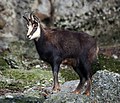Superregnum: Eukaryota
Cladus: Unikonta
Cladus: Opisthokonta
Cladus: Holozoa
Regnum: Animalia
Subregnum: Eumetazoa
Cladus: Bilateria
Cladus: Nephrozoa
Superphylum: Deuterostomia
Phylum: Chordata
Subphylum: Vertebrata
Infraphylum: Gnathostomata
Megaclassis: Osteichthyes
Cladus: Sarcopterygii
Cladus: Rhipidistia
Cladus: Tetrapodomorpha
Cladus: Eotetrapodiformes
Cladus: Elpistostegalia
Superclassis: Tetrapoda
Cladus: Reptiliomorpha
Cladus: Amniota
Cladus: Synapsida
Cladus: Eupelycosauria
Cladus: Sphenacodontia
Cladus: Sphenacodontoidea
Cladus: Therapsida
Cladus: Theriodontia
Cladus: Cynodontia
Cladus: Eucynodontia
Cladus: Probainognathia
Cladus: Prozostrodontia
Cladus: Mammaliaformes
Classis: Mammalia
Subclassis: Trechnotheria
Infraclassis: Zatheria
Supercohors: Theria
Cohors: Eutheria
Infraclassis: Placentalia
Cladus: Boreoeutheria
Superordo: Laurasiatheria
Cladus: Scrotifera
Cladus: Ferungulata
Cladus: Euungulata
Ordo: Artiodactyla
Cladus: Artiofabula
Cladus: Cetruminantia
Subordo: Ruminantia
Cladus: Pecora
Superfamilia: Bovoidea
Familia: Bovidae
Subfamilia: Caprinae
Genus: Rupicapra
Species: R. pyrenaica - R. rupicapra
Name
Rupicapra Garsault, 1764: pl. 704 (Welter-Schultes & Klug, 2009)
Type species: Capra rupicapra Linnaeus, 1758, by absolute tautonymy by Blainville (1816: 75). [also by subsequent designation; also fixed under the plenary power in Opinion 91]
Note:: Rupicapra as used by Blainville, 1816 is a subsequent use of Rupicapra Garsault, 1764. (Welter-Schultes & Klug, 2009)
References
Primary references
Garsault, F.A.P. de 1764. Les figures des plantes et animaux d'usage en médecine, décrits dans la Matière Médicale de Mr. Geoffroy Médecin, dessinés d'après nature. Gravés par Mrs. Defehrt, Prevost, Duflos, Martinet &c. Niquet scrip. Vol. 5. pl. 644–729. Paris: Desprez. BHL. Reference page.
Welter-Schultes, F.W. & Klug, R. 2009. Nomenclatural consequences resulting from the rediscovery of Les figures des plantes et animaux d’usage en médecine, a rare work published by Garsault in 1764, in the zoological literature. Bulletin of Zoological Nomenclature 66(3): 225–241. DOI: 10.21805/bzn.v66i3.a1. Reference page.
Additional references
Rupicapra in Mammal Species of the World.
Wilson, Don E. & Reeder, DeeAnn M. (Editors) 2005. Mammal Species of the World – A Taxonomic and Geographic Reference. Third edition. ISBN 0-8018-8221-4.
Vernacular names
English: Chamois
español: Rebecos
suomi: Gemssit
magyar: Zergék
Rupicapra is a genus of goat-antelope called the chamois. They belong to the bovine family of hoofed mammals, the Bovidae.
Two extant species are recognized.[1]
| Image | Scientific name | Common Name | Distribution |
|---|---|---|---|
 |
Rupicapra rupicapra | Alpine chamois | the mountains of southern and central Europe and Turkey and the Caucasus in southwest Asia |
 |
Rupicapra pyrenaica | Pyrenean chamois | the Pyrenees (a mountain range in southwestern Europe) and Apennines |
The Apennine chamois (Rupicapra pyrenaica ornata)[2] is a subspecies of the Pyrenean chamois, a goat-like mammal found in the mountains of Europe. Both male and female have hook-shaped horns that slightly curl backwards and grow little by little each year, never falling off. Their coats are light brown in the summer and darker in the winter, with a light colored mark on the throat. There are also two darker bands on their flanks.
In the summer, the Apennine chamois prefers rock faces and pasture lands at heights above 1700 meters for its habitat, and in the winter it prefers to retreat to the woods below. Diet of the chamois consists of grasses, leaves, buds, shoots and fungi. Adult males prefer a solitary life, only approaching females during the mating season. Groups consist only of females, young males, and "kids." Females give birth to only one kid after a gestation period of 23 to 24 weeks.[3]
A 2014 study by Durham University discovered that these goats are shrinking in size due to global warming and climatic changes.[4]
References
Grubb, P. (2005). "Order Artiodactyla". In Wilson, D.E.; Reeder, D.M (eds.). Mammal Species of the World: A Taxonomic and Geographic Reference (3rd ed.). Johns Hopkins University Press. pp. 711–712. ISBN 978-0-8018-8221-0. OCLC 62265494.
"ITIS - Report: Rupicapra pyrenaica ornata". www.itis.gov. U.S. Fish and Wildlife Service.
"Apennine Chamois Facts - Photos - Earth's Endangered Creatures".
"Mountain Goats Are Shrinking—A Lot—Because of Global Warming". National Geographic Society. Archived from the original on January 24, 2018. Retrieved 23 October 2014.
External links
Garsault, F.A.P. de 1764. Les figures des plantes et animaux d'usage en médecine, décrits dans la Matière Médicale de Mr. Geoffroy Médecin, dessinés d'après nature. Gravés par Mrs. Defehrt, Prevost, Duflos, Martinet &c. Niquet scrip. Vol. 5. pl. 644–729. Paris: Desprez. BHL. Reference page.
Welter-Schultes, F.W. & Klug, R. 2009. Nomenclatural consequences resulting from the rediscovery of Les figures des plantes et animaux d’usage en médecine, a rare work published by Garsault in 1764, in the zoological literature. Bulletin of Zoological Nomenclature 66(3): 225–241. doi:10.21805/bzn.v66i3.a1. Reference page.
Wilson, Don E.; Reeder, Deeann M. (2005). Rupicapra in Mammal Species of the World. Wilson, Don E. & Reeder, DeeAnn M. (Editors) 2005. Mammal Species of the World – A Taxonomic and Geographic Reference. Third edition. ISBN 0-8018-8221-4.
Retrieved from "http://en.wikipedia.org/"
All text is available under the terms of the GNU Free Documentation License

